

Flow: an evolution of Coordinator for iOS - TransferWise Engineering - Medium. Defining Flows to allow composition of smaller ones to create a more complex Flow Introduction We have already seen many articles about Coordinators, each one bringing a different flavour.
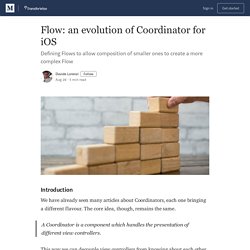
The core idea, though, remains the same. A Coordinator is a component which handles the presentation of different view controllers. This way we can decouple view controllers from knowing about each other (increasing reusability also).At the same time, a Coordinator encapsulates logically a set of view controllers, creating a new module, which is easier to reason about. At TransferWise, we already use the concept of flow throughout the company, which is a sequence of steps (screens and user interactions) to achieve a final result.For example, the Transfer Flow is in charge of gathering all the data in order to send a payment from A to B: this encapsulates a set of different operations.
Coordinator: The Missing Pattern In UIKit (UIResponder - Responding Chain) Iosdev I am having so much benefit from using this pattern in last few years, I can’t help myself.
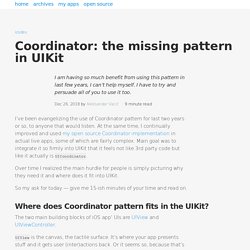
I have to try and persuade all of you to use it too. Deallocation in Coordinator Pattern. Coordinators changed the way we develop iOS Apps.

They allow to have better control of the navigation flow in a way that is clean, simple and easy to use. However, there is one aspect of this pattern that might lead to memory leaks and this is that you are in control of the coordinator’s lifecycle so you have to manually deallocate them. This is not bad if you are careful and you have control of what is happening. Sadly that might not be always the case, specially when dealing with UIViewController/UINavigationController. The actual scenario. Highly maintainable app architecture · aplus.rs.
Iosdevswift Expanded transcript from my talk at NSSpain 2017 Maintainable can mean different things, depends on many factors: project size, goal, 3rd-party service dependence and availability.
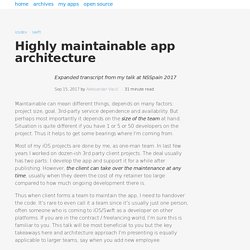
So Swift, So Clean Architecture for iOS. You are not paid to code; you are paid to create solutions.
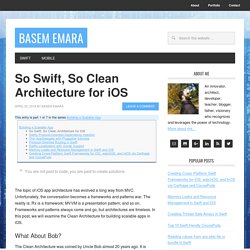
The topic of iOS app architecture has evolved a long way from MVC. Unfortunately, the conversation becomes a frameworks and patterns war. The reality is: Rx is a framework; MVVM is a presentation pattern; and so on. Building µFeatures – iOS App Development. You can check out the guidelines and other related projects on this GitHub organization.

What 🤔 uFeatures is an architectural approach to structure iOS applications to enable scalability, optimizing build and testing cycles, and ensuring good practices in your team. Coordinator and FlowController. iOS Architecture: A State Container based approach – Jobandtalent Engineering. View-state driven applications. Cocoa applications are traditionally “presentation driven”.
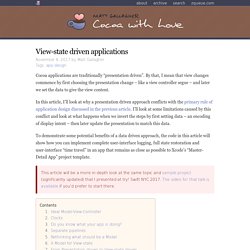
By that, I mean that view changes commence by first choosing the presentation change – like a view controller segue – and later we set the data to give the view content. In this article, I’ll look at why a presentation driven approach conflicts with the primary rule of application design discussed in the previous article. I’ll look at some limitations caused by this conflict and look at what happens when we invert the steps by first setting data – an encoding of display intent – then later update the presentation to match this data. Break the Monolith with (B)Viper Modules. Building a Framework with VIPER. Introduction My name is Sonam, I am a senior iOS engineer at ustwo. ustwo is the company that made Monument Valley.
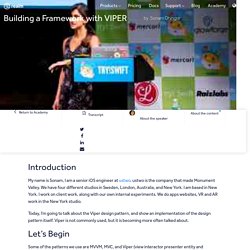
We have four different studios in Sweden, London, Australia, and New York. I am based in New York. I work on client work, along with our own internal experiments. We do apps websites, VR and AR work in the New York studio. Today, I’m going to talk about the Viper design pattern, and show an implementation of the design pattern itself. Let’s Begin Some of the patterns we use are MVVM, MVC, and Viper (view interactor presenter entity and router), which leaves a lot of people either intimidated, confused or scared. Architectural Superpowers. We usually hear about intangible or difficult to measure benefits of implementing a good architecture.

I would like to prove to you that the benefits are far more mundane. In this trySwift talk, I will showcase practical, real-world examples of how a good architecture for your application makes your life easier. Using my interpretation of the Clean Architecture for iOS in Swift, I will show how it helps to do things such as reusing an existing use case in another view controller, or using a different backend, in case we are forced to do so.
I will also cover briefly how this architecture helps with testability. #24 Architecture Wars – A New Hope – swifting.io. Modern RxSwift Architectures. Reactive Programming with RxSwift. You may have heard about reactive programming, and maybe even checked out RxSwift.
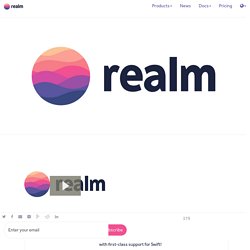
But if you’re not using it in your daily development, you’re really missing out! During this talk at AltConf 2016 Scott Gardner introduces you into the world of reactive programming, giving you an easy way to start off learning Reactive Swift. He takes a look into RxSwift while also giving you many other resources that will guide your learning. ReactiveCocoa and MVVM, an Introduction · Sprynthesis. 06 Dec 2014 Anyone who has been developing software for a decent length of time is familiar with MVC. It stands for Model View Controller, and is a proven pattern for organizing your code in complex application design. It’s also proven to have a second meaning in iOS development: Massive View Controller. It leaves a lot of developers scratching their heads as to how to keep their code nicely decoupled and organized.
As a whole, iOS developers have come to the conclusion they need to slim down their view controllers, and further separate concerns; but how? Taming Great Complexity: MVVM, Coordinators and RxSwift. MVVM-C In Practice. Storyboards and Their (Better) Alternati... It seems that in almost every iOS project, one of the first questions developers ask themselves is: Should we use storyboards, XIBs or write the whole UI in code? It’s always hard to answer it because preferences tend to vary even among members of the most closely-knit teams. However, enforcing a consistent approach to the way UI flow is handled within an app almost always results in higher quality of the project. Every decision of this magnitude requires the team to take a closer look at the pros and cons (or tradeoffs ) of all available solutions. 1. What exactly is a storyboard in the context of iOS development? A file that contains a visual representation of the app’s UI (user interface), showing screens of content and the transitions between them, that you work on in Interface Builder.
When you create a new project using any of the iOS → Application templates, you end up with a Main.storyboard file in your project. Coordinators Redux. I wrote about coordinators at the beginning of the year, but the idea has matured a lot since then, and I’d like to reintroduce the topic with all of my learnings from the last few months. This is adapted from a talk I gave at NSSpain this year. You can find the slides here. You can find the video here. Coordinators with Storyboards — Apokrupto. I recently discovered Soroush Khanlou's NSSpain presentation on Coordinators, and once more I'm architecturally smitten. In short (and I'm being free and easy with the reality and details here, I admit), a view controller should not know about it's place in the hierarchy, therefore a coordinating object is used to push and pop view controllers as the need arises.
For all the details I recommend the video, or Soroush's blog post, or another post by Krzysztof Zabłocki where he writes about what he calls Flow Controllers, but the idea is more or less the same. I got very excited. I strive to get things as architecturally 'correct' as possible. Obviously there's no such thing as a universally accepted definition of correct, but when smart people talk, you shut up and listen. There may be trouble ahead As a developer there are a number of things I like, chief among them being lazy. Another thing I like, and it appeals to my laziness, is using Storyboards. Nuts. So, that's it, then? Better MVVM setup with POP and Runtime. Even if we are writing pure Swift code in our app, we still deal with Objective-C Frameworks like UIKit.
Let’s take a look at how we can improve our MVVM architecture by leveraging a little bit of Objective-C runtime and Protocol Oriented Programming. Popular MVVM setup. Introduction to Protocol-Oriented MVVM, with Natasha Murashev. MVVM at Scale: Not so Simple... MVVM is Exceptionally OK - Ash Furrow. MVVM in Swift - Artsy Engineering. Unidirectional Data Flow in Swift: An Alternative to Massive View Controllers. Many iOS developers are familiar with the problem of the “Massive View Controller” - a component that clearly oversteps its role within the Model-View-Controller architecture. The community has come up with different approaches to avoid it, including the usage of alternative architectures. In this talk, Benjamin Encz explores using the popular architecture of Redux and Flux in Swift.
Flux enforces a unidirectional data flow that reduces unnecessary code complexity, and a Swift implementation of that concept leads to fascinating results. iOS Architecture Patterns — iOS App Development. Refactoring Massive App Delegate. App delegate connects your app and the system and is usually considered to be the core of every iOS project. The common tendency is that it keeps growing as the development goes, gradually sprouting with new features and responsibilities, being called here and there and eventually turning into spaghetti code. The cost of breaking anything inside the app delegate is extremely high due to the influence it has over your app. Undoubtedly, keeping this class clean and concise is crucial for the healthy iOS project. Service-oriented AppDelegate – iOS App Development – Medium.
App Architecture and Object Composition in Swift – Flawless App Stories. Architecting for Features. The Clean Architecture. Dynamic Modular iOS Architecture (Library - Framework - Static - Dymanic) Extend Modules With a Plugin Architecture. Deep Linking (Routing - FlowController - Universal links - State Machine - Future - Promise) Advanced Deep Linking (Routing) Dependency Injection via Property Wrapper. Dependency Injection With Protocol Compositon. Dependency Injection. Dependency Injection on iOS (Swinject - MVVM - Testing) Swinject In Practice (Dependency Injection - Assembly) Declarative Code With Result Extensions (Error - Validation) Monadic Computation (Result - Functional) Functional Reactive Programming (FRP - Rx) Result Oriented Development (Functional - Monad) State Pattern (State Machine - Design Pattern) That One Optional Property (Enum - State - Promise) Enums As Configuration: The Anti-Pattern (Struct) Analytics Service (Architecture - Providers) Feature Toggle Architecture - (A/B Test)
Reducers (State - Command - Redux) Protocol-Oriented Programming (WWDC) Controlling Complexity (Model - Value Type - Struct)